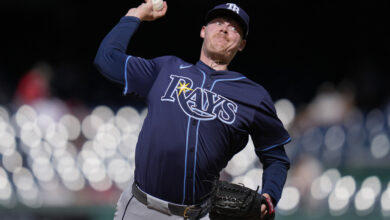
David Ross Just Looking for Some Relievers to ‘Get Outs, Throw Strikes’
The season is only a week old, but the Cubs are already making moves to address the long-running issue of a bullpen that can’t seem to throw enough strikes. Repeated failures by multiple pitchers have led to identical 9.64 marks in both ERA and BB/9, both of which sit well above the next-worst unit in each category.
Cubs bullpen has walked 20 of the 95 batters they've faced, 21.1% walk rate. ERA is 9.64. Not great!
— Sahadev Sharma (@sahadevsharma) July 30, 2020
The first corrective procedure involved swapping out Dillon Maples, who walked four of the six batters he faced on Wednesday, for Colin Rea, though that alone won’t turn anything around. The Cubs also signed former Indians closer Cody Allen to a minor league deal and assigned him to South Bend, where he’ll try to overcome his own monumental control issues.
But since there’s no way to swap out the entire relief corps, David Ross is going to have find a way to either organize or motivate his pitchers to do what everyone at home is probably yelling at their TVs in the late innings.
“I’m looking for someone to get outs, throw strikes,’’ Ross told reporters Thursday before the game was rained out. ‘‘Way too many walks from down there. We’ve got some guys that have to kind of step up, and that’s some of the stuff that we’re finding out here early. We can match up as much as we want, but guys still have to come in and throw strikes.’’
Seems simple enough, right? It might be easy enough to assume that everything will just work itself out as the season progresses, but this isn’t just a 2020 thing. Nor is it simply carryover from from last season. No, the issue with Cubs relievers issuing too many walks goes back much further.
“[The walks are] sort of systemic across the board,” Theo Epstein told 670 The Score late in the 2017 season. “So we have to find a way to address that going forward, and we will. Some of it is obviously personnel based, and it will be important for us to bring in some reliable strike-throwers going forward out of the pen.
“I know our pitching infrastructure is awesome, and I love them and we do so many things right. But I think the fact that it’s been two years in a row where we haven’t really thrown strikes and that most of our relievers have taken a step back with their strike throwing, that falls on me. We gotta find a way to fix it through personnel and also looking at our approach a little bit.”
Late in 2017, folks, we’re talking almost three full years ago.
Rather than turning this into some sort of gotcha moment, I just want to illustrate how difficult it can be to put together an effective bullpen. Look at the Rockies, who went out and spend a boatload of money on three relievers a couple winters ago only to end up with an overpriced collection of guys they couldn’t trust in high-leverage situations. When you work in small samples, the results can swing from really good to really bad in an instant and can stay that way for a whole season.
Players are pushing to keep rosters expanded to 30 for more than the initial two weeks, but you have to wonder whether trimming one or two pitchers might be better for the Cubs. The abbreviated spring and summer camps offered very little time to establish a rhythm in the first place, and carrying 11 relievers leads to anything but continuity. Maybe giving a rookie manager fewer choices is a good thing.
Of course, it means nothing if too many of those remaining choices can’t locate their pitches well enough to keep hitters from reaching base. It sounds like the simplest thing in the world, but here we are still perseverating on an issue that’s been around since the Cubs won the World Series.

